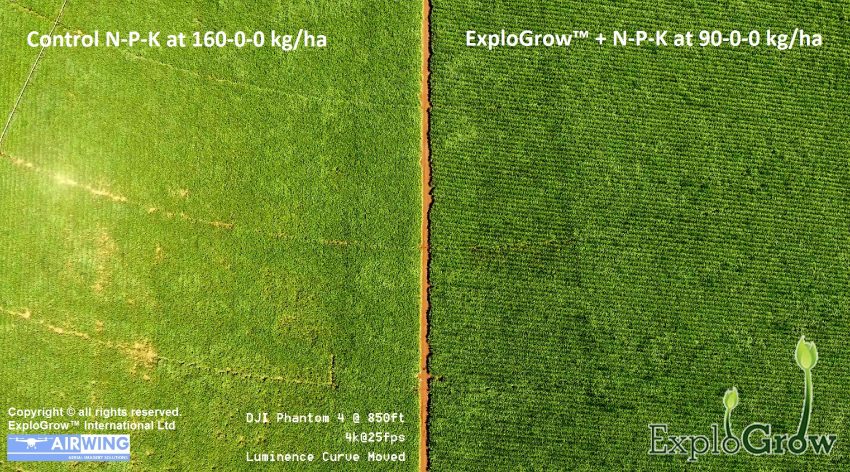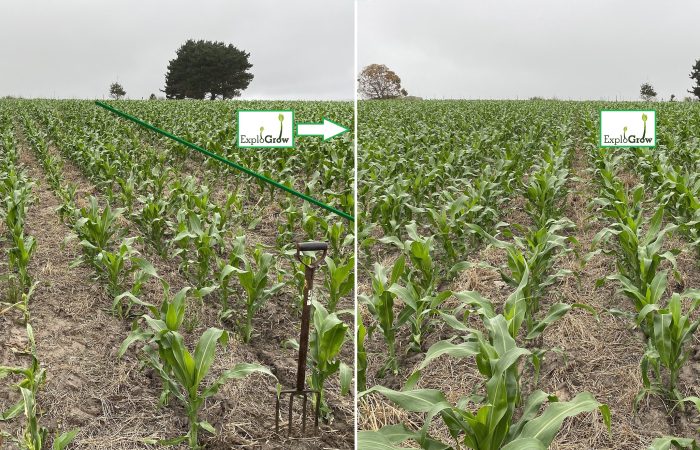Why it is possible to reduce Nitrogen, Phosphorus and Potassium (NPK) fertilizers by using beneficial soil microbes


By Mark Young BSc, Sustainability Lecturer, Permaculture Technician, heading up sustainability research at The Centre for Sustainable Development. As Farm Production Manager, Mr Young became one of the leaders in South African microbial approach in agriculture, also for pest and disease control. Mr Young’s botanic biologist qualifications include post graduate experience in the US on plant growth, organic, bacterial and indigenous microorganism management.
Nitrogen (N) makes up approximately 79% of the atmosphere. Even though there is an abundance of Nitrogen in the atmosphere, plants’ ability to take advantage of this is very limited.
Atmospheric Nitrogen is only readily available to a couple of plant species with the assistance of symbiotically associated N-fixing microbes.
Microbes have a profound effect on transformation of Nitrogen from the atmosphere into the soil. However, Nitrogen is not the only element microbes can effectively fix into the soil. Microbes can solubilize Phosphorous and Iron among other elements. They also play a very important role in decomposition of organic matter, enhancing enzyme synthesis and production of hormones within plants.
[References: 1, 3-8, 10, 13-15]
Plants are unable to convert Nitrogen from the atmosphere into Ammonia.
However: Rhizobia bacteria – consisting of Azospirillum, Enterobacter, Azorhizophillus, Sinorhizobium and Azotobacter sp - colonize the soil surface, the interior of roots and occasionally even the stems and leaves, and can reduce Nitrogen into Ammonia.
This Ammonia is therefore a readily available Nitrogen source for the plants. Rhizobia can fix between 100kg and 300kg of Nitrogen per year depending on environmental factors.
[References: 1, 3-8, 10, 13-15]
ExploGrow™ contains several Nitrogen fixing Rhizobia microbes, all of which can fix Nitrogen from the atmosphere into readily available Nitrogen in the soil and the plants’ cells.
ExploGrow™ also contains Bacillus licheniformis which is responsible for breaking down organic matter and plays an extremely important role in the general nutrient cycling in soils.
Other ExploGrow™ microbes enhance nutrient cycling, enzyme synthesis and hormone production, and insect and fungal biological control.
[References: 9]
All of these microbes are generally available in most soils - but at very low concentrations.
Inoculating soils with concentrated doses and improving the health of the soil with carbon and organic matter will drastically improve plant health and production.
Because ExploGrow™ is improving the health of the soil and the microbes are symbiotically bonding with plants there is a lesser need for chemical fertilizers. The fertilizer is already all around us, but it is just not readily available.
In essence: microbes are extremely efficient at converting nutrients locked up in the atmosphere and soil that are not readily available, into forms that are readily available.
Phosphorous occurs mostly in insoluble forms in the soil and the synthesis of Phosphorous is an energy intensive process. Research suggests that the soil contains enough accumulated organic Phosphate to last up to 100 years, if ONLY it could be accessed by the plants.
Psuedomonas and Bacillus are recognized as Phosphate solubizing microbes and play a major role in the mineralization of organic Phosphorous. Unfortunately, Psuedomonas does not occur naturally in high populations in the soil.
Soil inoculation with ExploGrow™ will supply the soil with the correct amount of Psuedomonas and Bacillus that will be able to synthesise organic Phosphates and make it readily available to the plants' root systems. The symbiotic relationship allows plants to absorb Phosphates more easily. Psuedomonas microbes also suppress pathogens in the root system through hormone production which ultimately promotes plant resistance to diseases, and promotes growth.
[References: 2, 12, 16]
Bacillus plays a major role in nutrient cycling by breaking up organic matter in the soil. This organic matter often has several different nutrients including Potassium. By processing this organic matter and reducing it into simpler nutrients, those nutrients become readily available to the plants root systems.
[References: 9]
Because microbes have these very efficient physiological process capabilities, it is recommend to reduce chemical fertilizer inputs by 25%-50%. Even more in some specific cases. Excessive use of chemical fertilizers damages the health of the soil and often cause damage downstream through processes like Eutrophication and leaching.
With a poly-microbial approach:
- farming gets better year on year
- the plant’s own wonderful inherent capabilities are maximised
- the usage of chemicals and poisons are minimised
- the plants reach their highest levels of capability to produce optimal yields, and reach their maximum natural level of health, strength and resistance to disease and extreme weather
By Leon du Plessis C. Eng. (UK); CIGC (USA); HND. Microbiology – Path (RSA); CIA. Agricultural Regulatory Services. PSCA Membership No. 76/2014 Specialist.
The ExploGrow™ uniquely formulated poly-microbial blend presents an exclusive opportunity to South African farmers to decrease fertilizer input on a productivity base – provided the concepts below are adhered to. Such application will have a marked positive impact on profits, sustainability, soil & crop quality.
ExploGrow™ being organic, cannot completely replace Inorganic Fertilizers.
Farmers need to replace whatever nutrients were taken [used] from the soil. The Soil Status and Crop Specific Nutritional Requirements determines to what extent these nutrients need to be replaced and increased if need be. In an ecological holistic sense, Organic Fertilizers and Bio-fertilizers have the ability to, amongst others, improve Soil Health resulting in increased availability of nutrients that are “locked up” – fixed or adsorbed onto soil particles, through improved cation exchange*. Other factors such as the soil nutrient balance plays an important role as well. Therefore, the role of comprehensive Soil Analysis must not be underestimated in determining soil/crop specific nutrient requirements.
* ["Cation Exchange Capacity" (CEC) is the total capacity of a soil to hold exchangeable cations. CEC is an inherent soil characteristic and is difficult to alter significantly. It influences the soil's ability to hold onto essential nutrients and provides a buffer against soil acidification.]
By Dr Stephanus Malherbe, BSc; BSc Hons.; MSc (Microbiology); Pr.Sci.Nat. (Agricultural Science); PhD (Agronomy).
"The unique microbial composition places ExploGrow™ in a league all of its own".
REFERENCES:
1. Andrew, J.W., D. Jonathan, R. Andrew, S. Lei, N.N. Katsaridou, S. Mikhail and A.D. Rodionov, 2007. Living without Fur: the subtlety and complexity of iron-responsive gene regulation in the symbiotic bacterium Rhizobium and other a-proteobacteria. Biometals, 20: 501-511.
2. Banik S, Dey BK. Available phosphate content of an alluvial soil is influenced by inoculation of some isolated phosphate-solubilizing microorganisms. Plant Soil 1982;69:353–64. H. Rodríguez, R. Fraga/Biotechnology Advances 17 (1999) 319–339 337.
3. Doroshenko, E.V., E.S. Boulygina, E.M. Spiridonova, T.P. Tourova and I.K. Kravchenko, 2007. Isolation and characterization of nitrogen-fixing bacteria of the genus Azospirillum from the Soil of a Sphagnum Peat Bog. Microbiol., 76: 93-101.
4. Egamberdieva, D & Z Kucharova, 2008 Cropping effects on microbial population and nitrogenase activity in saline arid soil. Turk. J. Biol., 32: 85-90
5. Emtiazi, G., M. Pooyan and M. Shamalnasab, 2007. Cellulase Activities in Nitrogen Fixing Paenibacillus Isolated from Soil in N-free Media. World Journal of Agricultural Sci., 3: 602-608.
6. Frank, I.B., P. Lundgren and P. Falkowski, 2003. Nitrogen fixation and photosynthetic oxygen evolution in cyanobacteria.
Research in Microbiol., 154: 157-164.
7. Gonzalez, L.J., B. Rodelas, C. Pozo, V. Salmeron, M.V. Mart nez and V. Salmeron, 2005. Liberation of amino acids by heterotrophic nitrogen fixing bacteria. Amino Acids, 28: 363-367.
8. Hyoung, S.L., M. Munusamy, C.W. Kim, S. Choi, K.Y. Chung and M.S. Tong, 2006. Physiological enhancement of early growth of rice seedlings (Oryza sativa L.) by production of phytohormone of N2-fixing methylotrophic isolates. Biol Fertil Soils, 42: 402-408.
9. Monahan, Hajduk, Blaber, Charles and Harry 2014 Coordinating bacterial cell division with nutrient availability: a role for glycolysis. MBio. Vol 5:3
10. Peter, V.M., K. Cassman, C. Cleveland, T. Crews, B.F. Christopher, B.N. Grimm, W.R. Howarth, R. Marinov, L. Martinelli, B. Rastetter and I.J. Sprent, 2002. Towards an ecological understanding of biological nitrogen fixation. Biogeochemistry, 57: 1-45.
11. Rashid, H.K., M.D. Mohiuddin & M. Rahman, 2008. Enumeration, isolation and identification of nitrogen fixing bacterial strains at seedling stage in rhizosphere of rice grown in non-calcareous grey floodplain soil of Bangladesh. Journal: Faculty of Environmental Science and Technol. 13: 97-101
12. Ray J, Bagyaraj DJ, Manjunath A. Influence of soil inoculation with versicular arbuscular mycorrhizal (VAM) and a phosphate dissolving bacteria on plant growth and 32P uptake. Soil Biol Biochem 1981;13:105–8.
13. Requena, N., T.M. Baca and R. Azcdn, 1997. Evolution of humic substances from unripe compost during incubation with lignolytic or cellulolytic microorganisms and effects on the lettuce growth promotion mediated by Azotobacter chroococcum. Biol Fertil Soils, 24: 59-65.
14. Simon, T., 2003. Utilization of biological nitrogen fixation for soil evaluation. Plant Soil Environ., 49: 359-363.
15. Timothy, C.E., 1999. The presence of nitrogen fixing legumes in terrestrial communities: Evolutionary vs ecological considerations.
Biogeochemistry, 46: 233-246.
16. Toro M, Azcón R, Barea JM. Improvement of arbuscular mycorrhiza development by inoculation of soil with phosphate-solubilizing rhizobacteria to improve rock phosphate bioavailability (32P) and nutrient cycling. Appl Environ Microbiol 1997;63:4408–12.



